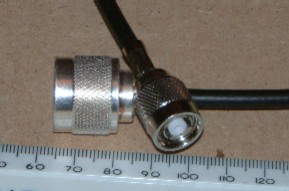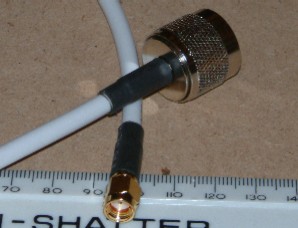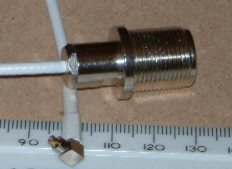
| Antenna Cabling Guide |
Introduction
Most commercial external antenna have an standard N-Type connector fitted, whereas most wireless devices (access-points, pci-cards, pcmcia cards) don't. To join the two ends together we need to To Check which type of connector you have, look on the cable connectors page.Connections
Whilst some manufacturers do sell cabling kits for joining antenna to wireless devices (usually access-points) they are both expensive, and only come in fixed lengths of cable. Ideally we want to to only use the minimum length of cable necessary, and save money by making as much as possible ourselves.Buying individual cable connectors for wireless devices can be difficult, both in correctly identifying the connector, and finding a supplier who sells them. In my experience it is easiest and cheaper to buy a short (50cm or less) converter cable from the manufacturer, which will have a standard N-Type connector on one end and the manufacturers connector on the other, ready for screwing straight onto the wireless device. These short cables are often refered to as pigtails.
There are three main types of converters, for TNC, SMA, and MC connectors.
 The TNC connector is usually found mainly on access-points, such as the Linksys WAP11.
The TNC connector is usually found mainly on access-points, such as the Linksys WAP11.
For TNC connectors I recommend the SMC cable SMCANT-CAB25, shown in the picture on the left. This has an N-Connector on one end, and a TNC connector on the other, and is 25 inches long.
There is also a 78 inch version, made from thicker cable (LMR-400) the SMCANT-CAB78. The shorter 25 inch cable is more flexible and cheaper, so can be easier to install. It should cost about 29 dollars (us).
 The SMA connector is found on both some access points such as from D-Link, and PCI wireless cards, such as the Belkin F5D6001 and the Netgear MA311.
The SMA connector is found on both some access points such as from D-Link, and PCI wireless cards, such as the Belkin F5D6001 and the Netgear MA311.
I can recommend the D-Link ECB-ANT240800 cable shown on the right, which is 50cm long, and has an N-connector on one end and an SMA connector on the other. They cost about 10 pounds (uk). I haven't found a US supplier yet, but when I do, I'll post it here.
 The MC connector, also often referred to as a Lucent connector, as it first appeared on pcmcia cards by Lucent, is usually found on pcmcia cards, such as the Buffalo WLI-PCM-L11G. I usually use the Buffalo pigtail WLE-LNC-3.
The MC connector, also often referred to as a Lucent connector, as it first appeared on pcmcia cards by Lucent, is usually found on pcmcia cards, such as the Buffalo WLI-PCM-L11G. I usually use the Buffalo pigtail WLE-LNC-3.
This is a short 12 inch cable with a female N connector on the end for connecting directly to an antenna cable, unlike the converters for TNC and SMA connectors which come with male N connectors. It should cost around 16 pounds (uk) or 18 dollars (us).
Positioning the Access point
In order to reduce the amount of signal lost due to the cable between the antenna and wireless device, ideally the wireless device, should be situated as close to the antenna as possible. Most access points are not waterproof, so need to be kept indoors. Ideally if the antenna is roof mounted, then positioning the access point in the loft will be the best solution. If you are connecting your antenna to a laptop or PC, then clearly the cable will have to run further, but you still need to try and route the cable so that it is as short as possible. A long cable run can easily negate the benefit of a root mounted antenna.
